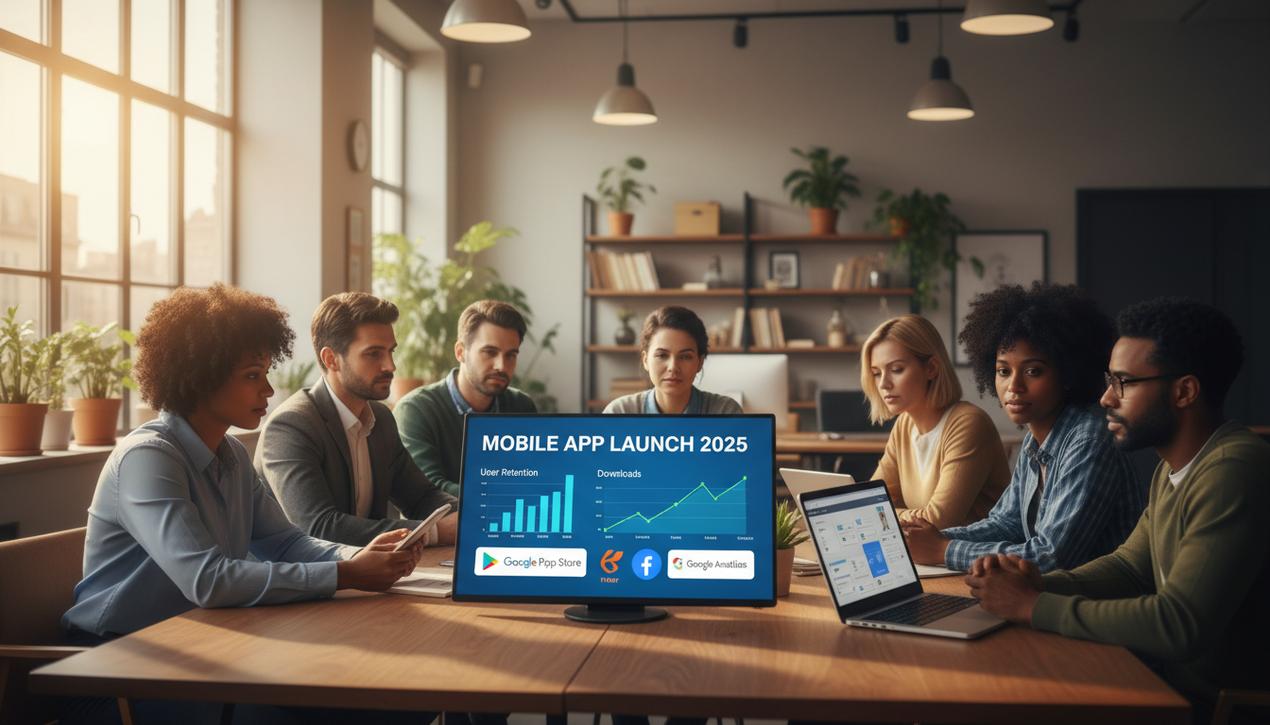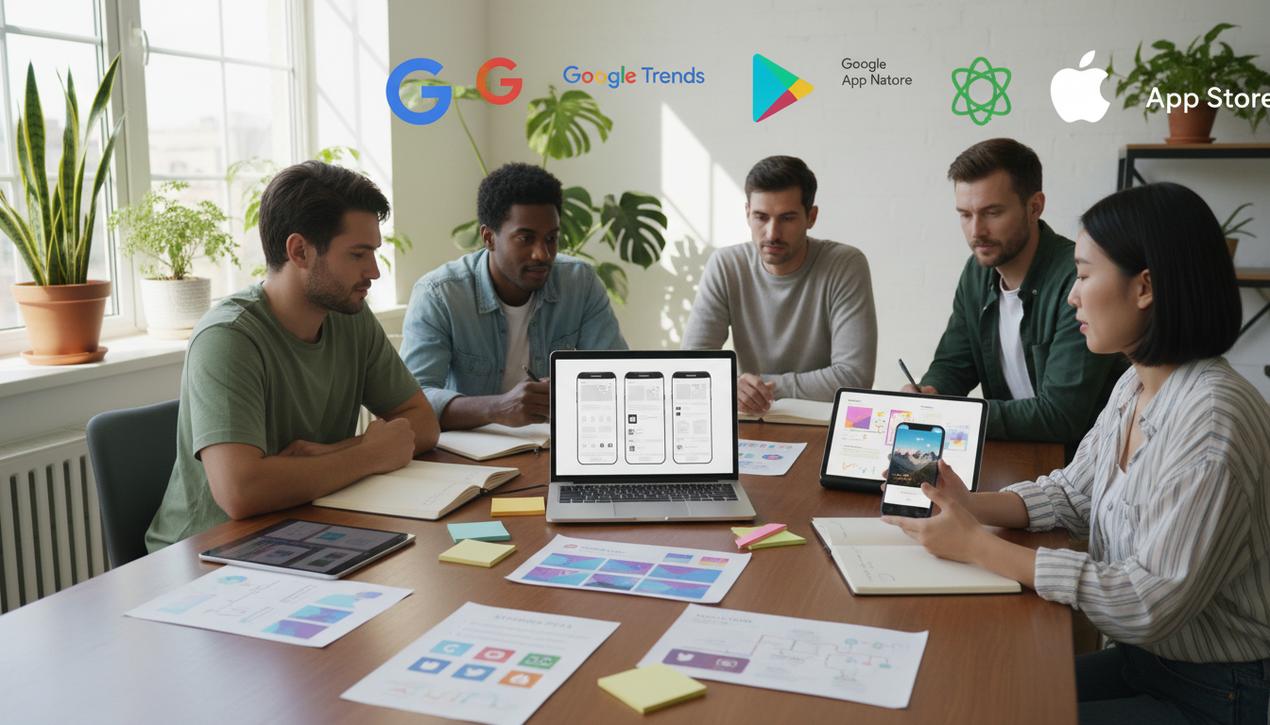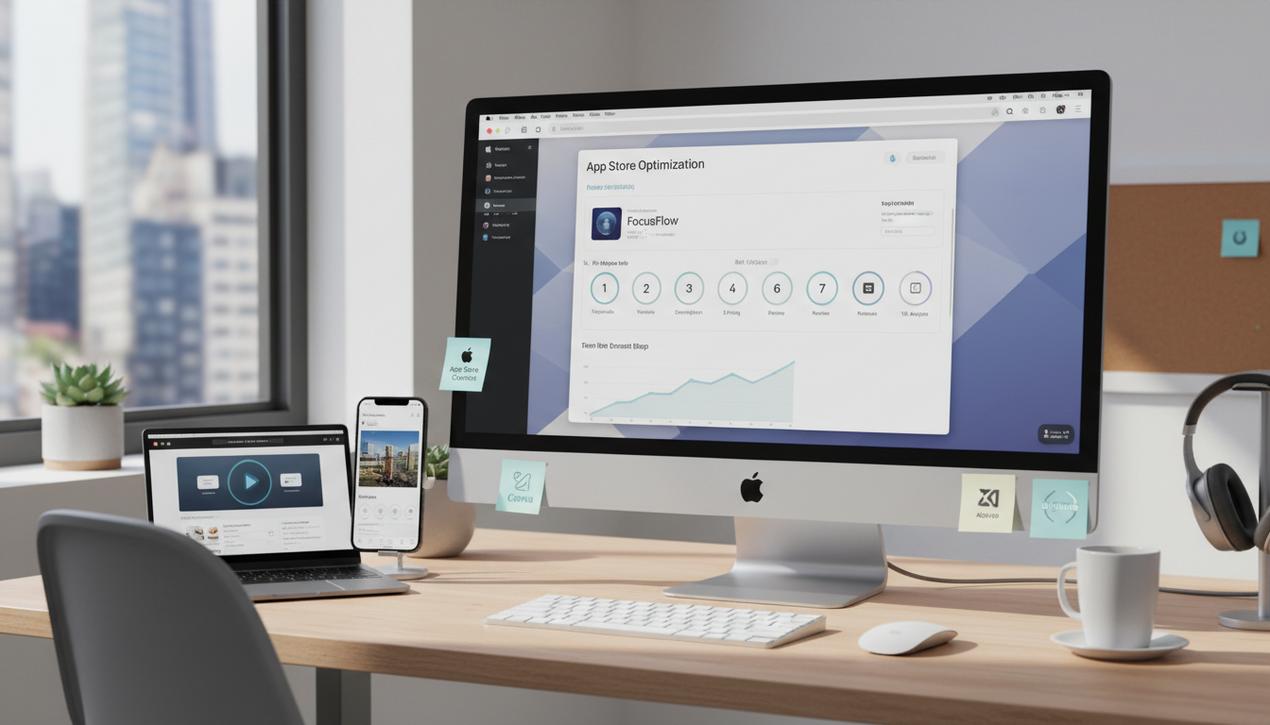How to Launch a Mobile App in 2025: The Complete Guide


Launching a mobile app is an exhilarating entrepreneurial journey, but it’s also fiercely competitive. The global mobile app market is projected to surpass $900 billion in revenue by the end of 2025, a figure that highlights both immense opportunity and intense rivalry. With over 5 million apps available across the Google Play Store and Apple’s App Store, carving out a space is a monumental task. The greatest challenge isn’t just acquiring users, but retaining them: nearly 75% of users uninstall an app within 90 days of downloading it. A successful app launch is not a mere technical formality; it’s the culmination of a meticulous strategy that begins long before the first line of code is written. From the initial idea to post-launch user retention, every step is critical. This comprehensive guide details 22 key steps to orchestrate a successful launch and transform your project into a sustainable success.
Phase 1: Strategy and Validation Before Development
Before even thinking about design or features, a solid strategic foundation, guided by successful project management, is essential. Skipping this phase is like navigating a crowded ocean without a map.
1. Conduct In-Depth Market Research
This is your starting point. Analyze the market: is it saturated or emerging? Identify your direct and indirect competitors. Download their apps, read user reviews (both positive and negative), and pinpoint their strengths and weaknesses. This analysis will help you define your unique value proposition (UVP): what will your app do better or differently?
2. Define a Clear Monetization Model
How will your app generate revenue? This decision must be made early on as it influences the design and user experience. It’s crucial to explore the different models to make money with an app to find the best fit. The options are varied:
- Freemium: Free to download with paid premium features.
- Subscription: Recurring access to content or services (the dominant trend in 2025).
- In-App Purchases: Selling virtual goods or one-off features.
- Advertising: Monetizing through banners, interstitials, or rewarded videos.
- Paid: A one-time purchase to download the app.
3. Validate the Idea with an MVP (Minimum Viable Product)
Don’t build your dream app right away. Develop an MVP, a version of your app that includes only the essential features needed to solve your target audience’s core problem. The goal is to quickly launch a functional version to test market appetite and gather valuable feedback without a massive initial investment.
4. Define Your Key Performance Indicators (KPIs)
How will you know if your launch is a success? Set measurable goals before launch day. Relevant KPIs include the number of downloads, retention rate at 7, 30, and 90 days, daily active users (DAU) and monthly active users (MAU), average app store rating, and, of course, revenue.
5. Choose the Right Platform (iOS, Android, or Both)
Launching on a single store (iOS or Android) can be a wise initial move. It reduces development and maintenance costs. The choice depends on your target audience and the specifics of each ecosystem, from how to create an Android app to the process to publish on the Apple App Store. Cross-platform technologies like Flutter or React Native are excellent options for developing on both systems simultaneously to optimize resources.
Phase 2: Pre-Launch Marketing and Communication
The buzz around your app should start long before it’s available for download. This is where you build your initial audience.
6. Create an Effective Landing Page
Even if your app isn’t launched yet, create a dedicated website or landing page. This space should clearly present your app’s value proposition, feature attractive visuals (mockups, screenshots), and, most importantly, include an email capture form so visitors can sign up to be notified of the launch.
7. Produce a Compelling Demo Video
A short video (30-60 seconds) is one of the most powerful marketing tools. Show your app in action. Focus on user benefits rather than just listing features. A professional video boosts credibility and can be used on your website, social media, and app store page.
8. Develop a Content Strategy
Start creating content relevant to your target audience: blog posts, infographics, case studies, etc. Position yourself as an expert in your niche. This content will improve your search engine optimization (SEO) and attract a qualified audience that you can later convert into users.
9. Engage on Social Media and Build a Community
Identify the platforms where your audience spends their time (Instagram, TikTok, LinkedIn, etc.) and start posting regularly. Share behind-the-scenes glimpses of development, ask for feedback from future users, and create a sense of belonging. An engaged community will be your best ambassador on launch day.
10. Organize a “Soft Launch”
A soft launch involves releasing your app in a limited, low-stakes market (e.g., a country with a similar language and culture) a few weeks before the official launch. This allows you to test server stability, analyze initial usage data, and fix major bugs without risking your reputation in your primary market.
11. Run an Invitation-Only Private Beta
Before the soft launch, invite a small group of users (from your email list or community) to test a beta version. This tactic creates a sense of exclusivity and provides you with invaluable qualitative feedback to refine the user experience (UX) and user interface (UI) before the public release.
Phase 3: Launch Day and the First Week
This is the moment of truth. All your preparation must converge to maximize visibility and downloads.
12. Master App Store Optimization (ASO)
ASO is the SEO of app stores. It’s a fundamental driver of visibility.
- Title and Keywords: The title should be unique and include your main keyword. Use all available keyword fields.
- Icon and Screenshots: These are your first visual touchpoints. They must be professional, clear, and attractive.
- Description: The first few lines are crucial. They must hook the reader and clearly explain the app’s benefits.
- Preview Video: A video directly on the store page can increase conversions by over 20%.
13. Reach Out to Press and Influencers
Prepare a comprehensive press kit (press release, visuals, video) and contact journalists and bloggers specializing in your industry. Do this at least two weeks before the launch to give them time to test the app. A feature in a reputable outlet can generate a massive spike in downloads.
14. Activate Your Professional and Personal Network
On launch day, mobilize your network. Send an email to all your contacts, post on your personal and professional profiles, and ask your inner circle to share the news. This initial push can create essential momentum.
15. Invest in Paid Advertising
Allocate a budget for targeted ad campaigns during the launch week. Platforms like Meta Ads (Facebook, Instagram) or Apple Search Ads are highly effective for acquiring qualified users and boosting your app store ranking.
16. Use In-App Events and LiveOps
Both Apple and Google allow you to promote events directly on your store pages (contests, feature launches, etc.). Use this feature to create urgency and interest during launch week.
17. Place Download Links Everywhere
Update all your communication channels: website, email signature, social media profiles. The download link should be visible and accessible in one click.
Phase 4: Post-Launch Growth and Retention
The launch is just the beginning. The real battle is for retention.
18. Actively Monitor Feedback
Read every review and comment on the app stores and social media. This is a goldmine of information. Respond quickly, especially to negative reviews, to show that you are listening and committed to improving your product.
19. Encourage Positive Reviews Intelligently
Don’t be intrusive when asking for a rating. Wait until a user has completed a positive action in the app, then ask them first if they are enjoying the experience. If they say yes, then suggest they leave a review. If they say no, prompt them to send private feedback.
20. Analyze Data and Iterate
Go back to your KPIs. Analyze user behavior with tools like Google Analytics for Firebase. Where are users dropping off? Which features do they use most? Use this data to guide your next updates.
21. Communicate Updates
Every update is an opportunity to re-engage your users. Communicate about new features and bug fixes. Show that your app is constantly evolving to meet their needs.
22. Connect with Other Developers
Establish partnerships with developers of apps that are complementary to yours. You can organize cross-promotions to reach new, qualified audiences at a lower cost.
The success of a mobile app launch is never a matter of luck. It is the result of a rigorous strategy, flawless execution, and constant listening to the market. By following these steps, from idea validation to retaining your first users, you are not just putting an app on the market; you are building the foundation for a viable and durable product. The work never stops: the cycle of analysis, iteration, and improvement is the key to turning a successful launch into long-term growth.




